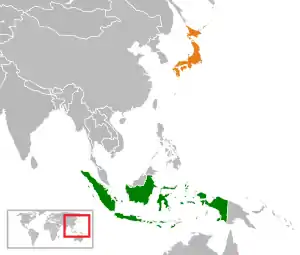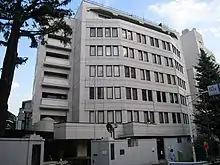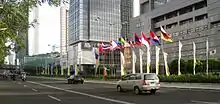Indonesia–Japan relations
Indonesia and Japan established diplomatic relations in April 1958. Both are two Asian nations that share historical, economic, and political ties. Both nations went through a difficult period in World War II when the then Dutch East Indies was occupied by the Imperial Japanese Army for three-and-a-half years.[1] Japan is a major trading partner for Indonesia.[2] Japan is Indonesia's largest export partner and also a major donor of development aid to Indonesia through Japan International Cooperation Agency. Indonesia is a vital supplier of natural resources such as liquefied natural gas to Japan. Both countries are members of the G20 and APEC. Today in Indonesia, there are about 11,000 Japanese expatriates whereas in Japan, there are approximately 24,000 Indonesian nationals working and training.
 | |
Indonesia |
Japan |
|---|---|
| Diplomatic mission | |
| Indonesian Embassy, Tokyo | Japanese Embassy, Jakarta |
Indonesia has an embassy in Tokyo and a consulate in Osaka. Japan has an embassy in Jakarta, consulate-general in Surabaya, and consulates in Medan, Denpasar and Makassar.
History
The linguist Ann Kumar (2009) proposed that some Austronesians migrated to Japan, possibly an elite-group from Java, and created the Japanese-hierarchical society and identifies 82 plausible cognates between Austronesian and Japanese.[3] However, Kumar's theory is controversial because it lacks archaeological, genetic, and linguistic evidence.[4]

Colonial–era relations
Especially in Nagasaki city, during power of Oda Nobunaga Daimyo, Sengoku period 16th century with the banishment of all Catholic missionaries, traders from Catholic countries were also forced out of the country. Along with them, their children, half Japanese and half European, were forced to leave. The majority was sent to Jagatara (Jakarta) and are still remembered by the locals as the people who wrote the poignant letters which were smuggled across the sea to their homeland.
Jagatara Oharu (じ ゃ が た ら 春 Oh, Oharu from Jakarta) or Jeronima Haru Marino (Jeronima Simonsen) (born in Nagasaki, 1625? - died in Batavia, April 1697 at the age of 72) who were driven out of Japan in the early Edo period, and later settled in Batavia, the Dutch East Indies.
In early 17th century Japanese settlers were first recorded to settle in Dutch East Indies. A larger wave came in the 17th century, when Red seal ships traded in Southeast Asia. In 1898 the Dutch East Indies colonial records show 614 Japanese residing in the Dutch East Indies (166 men, 448 women).[5] As the Japanese population grew, a Japanese consulate was established in Batavia in 1909, but for the first several years its population statistics were rather haphazard.[6] Beginning in the late 1920s, Okinawan fishermen began to settle in north Sulawesi. There was a Japanese primary school at Manado, which by 1939 had 18 students.[7] In total, 6,349 Japanese people lived in Indonesia by 1938.[8]
In 1942, the Empire of Japan invaded countries in Southeast Asia, including Indonesia. The Japanese seized the key oil production zones of Borneo, Java, Sumatera, and the Netherlands New Guinea (the modern day Indonesian province of Papua, which was also conveniently abundant in highly valuable copper) of the late Dutch East Indies, defeating the Dutch forces and were welcomed by many as liberating heroes by Javanese natives. Many natives saw as the realization of an indigenous Javanese prophecy. The Japanese encouraged the spread of Indonesian nationalist sentiment. Although this was done more for Japanese political advantage than from altruistic support of Indonesian independence, this support created new Indonesian institutions and elevated political leaders such as Sukarno. Through recruiting Indonesian nationalist leaders, the Japanese attempted to rally Indonesian support and mobilize the Indonesian people in support of the Japanese war efforts. The experience of the Japanese occupation of Indonesia varied considerably, depending upon where one's location and social position. Many who lived in areas considered essential to the war effort endured torture, Sexual slavery, arbitrary arrest and execution, and other war crimes. Many thousands of people were taken away from Indonesia as forced laborers, or romusha, for Japanese military projects where there was a very high death rate.
To gain military support from Indonesian people in their war against Western Allied force, Japan began to foster the Indonesian nationalistic movement by providing Indonesian youths with military training and weapons, including the formation of a volunteer army called Pembela Tanah Air (PETA; Defenders of the Homeland). The Japanese military training of Indonesian youths originally was intended to rally the local's support to bolster the collapsing power of the Japanese Empire. However, later this military training became a significant asset for the Indonesian Republic during the National Revolution from 1945 to 1949.
In 1945, with the Japanese on the brink of defeat, the Dutch sought to re-establish their authority in Indonesia, and requested the Japanese army "preserve law and order" in Indonesia.[9] Unfortunately for the Dutch, the Japanese favored helping Indonesian nationalists prepare for self-government. On 7 September 1944, as the war was going badly for the Japanese, Prime Minister Kuniaki Koiso promised independence for Indonesia, although the Prime Minister failed to set a date for this independence.[10] On 29 April 1945, Japanese 16th Army force formed the BPUPK (Japanese: Dokuritsu Junbi Chou-sakai), a Japanese-organized committee to work on "preparations for independence in the region of the government of this island of Java".[11] The organization was founded on 29 April 1945, by Lt. Gen. Kumakichi Harada, the commander of 16th Army in Java. It discussed matters related to Indonesian independence, although the later Indonesian Proclamation of Independence on 17 August 1945 was carried out independently by Sukarno and Hatta without the official support of Japan.[12]
Post-Independence era relations

After the end of Japanese occupation, roughly 3,000 Imperial Japanese Army soldiers chose to remain in Indonesia and fight alongside local people against the Dutch colonists in the Indonesian National Revolution; roughly one-third were killed, of whom many are buried in the Kalibata Heroes Cemetery, while another third chose to remain in Indonesia after the fighting ended, some of them becoming decorated as Indonesian independence heroes.[13][14]
After the Indonesian Revolution, Indonesian independence was recognized by the end of 1949. In the mid-1950s, talks between Japan and Indonesia began on war reparations after the San Francisco Agreement was signed, and finalized with the Agreement on Compensation and the opening of diplomatic relations in 1958.[1] The bilateral diplomatic relations between Republic of Indonesia and Japan officially established in April 1958.[2]
In the 1970s, Japanese manufacturers, especially those in the electronics sector, began establishing factories in Indonesia; this encouraged the migration of a new wave of Japanese expatriates, mainly managers and technical staff connected to large Japanese corporations.[15] The Japanese automotive industry also began to dominate Indonesian market and today Japanese car manufacturers enjoys the largest market shares in Indonesia. Simultaneously Japanese consumer products began to pour into Indonesian market.
However the Japanese economic domination over Indonesia has led to the popular opposition that escalated into the Malari incident, (abbreviation of Indonesian: Malapetaka Limabelas Januari or "Fifteen January disaster") when anti-Japanese and anti-foreign investment demonstrations led to riots on 15 January 1974, during Japanese Prime Minister Kakuei Tanaka's state visit to Jakarta on 14—17 January 1974.
Japanese investment in Indonesia has steadily increased since the 1980s continued well to 21st century.
Economic relations
In 2012, there were between 1,200 and 1,300 Japanese corporates operating in Indonesia, with some 12,000 Japanese nationals living in Indonesia.[2] Japan has been investing in Indonesia for decades, particularly in the automotive, electronic goods, energy, and mining sectors. Prior to the formation of the Indonesian Republic, the Japanese had viewed Indonesia as an important source of natural resources. The Japanese need of natural resources was among the reasons that led the nation to advance further to the south in their military conquests during World War II. Today Indonesia is Japan's major supplier for natural rubber, liquefied natural gas, coal, minerals, paper pulp, seafood such as shrimp and tuna, and coffee. Traditionally Indonesia has been regarded as a major market of Japanese automotive and electronic goods. For Japanese businesses, Indonesia has been a location for low-cost manufacturing operations as well as being the source of various natural resources required by those operations. Approximately 1,000 Japanese companies operate in Indonesia which employ approximately 300,000 people.[16] Major Japanese factories are concentrated east of Jakarta with high concentrations in Bekasi, Cikarang and Karawang, West Java.
A new trend in Japanese direct investment in Indonesia has emerged as a result of increasing incomes, a large population, and the increase in consumption of consumer goods in Indonesia. Consequently, Japanese direct investment is no longer limited to traditional sectors but now also include retail, media, and consumer products sectors. Japanese restaurant chains such as Ootoya, Yoshinoya, Sukiya and Ebisu Curry, fashion, retail and household appliances stores such as Sogo, AEON and MUJI, and bookstores such as Books Kinokuniya have recently entered the market in Indonesia. Taisho Pharmaceutical Co. recently acquired Bristol Myers Indonesia. The investment of these new corporations is encouraged by the success of several Japanese companies. Ajinomoto is planning the construction of a new US$50 million factory in Indonesia.
The trend of bilateral trade volume in the 2007-2011 period revealed an average increase of 11.97 percent per year, as the bilateral trade figures shows significant increase from US$30.15 billion in 2007 to US$53.15 billion in 2011.[2] Trade between two countries amounted to about $37.44 billion in 2018, ranked Japan as Indonesia's 2nd largest trading partner behind China ($72.67 Billion).[17]
On 20 October 2020, Japanese PM Yoshihide Suga visited Indonesia,[18] and pledged low-interest loans of ¥50 billion ($473 million) to Indonesia in talks with the Southeast Asian nation's President Joko Widodo to help it cope with the economic fallout from the coronavirus pandemic.[19]
Cultural exchange and tourism

Japanese culture is well known in Indonesia, ranging from the traditional hallmarks such as Japanese cuisine, kimono, origami, samurai and karate, to modern culture including manga, anime, video games, J-pop, and the motorsport disciple of drifting. Popular Japanese animation programmes such as Doraemon, Power Rangers and Crayon Shinchan, as well as video games such as Super Mario, Street Fighter and Final Fantasy have gained popularity among Indonesians since the late-1990s. JKT48, based in Jakarta, was the first overseas sister group of AKB48, a popular J-pop band. Conversely, many Japanese have become interested in Indonesian culture. Indonesian cultural icons such as batik, gamelan, and Indonesian dances have gained Japanese attention. Bali and Borobudur have become popular destinations for Japanese tourists: Japan is one of the largest sources of tourism in Bali.
There are over 85,000 Indonesians studying the Japanese language, the largest number in Southeast Asia and the sixth largest in the world. The Indonesian interest in the Japanese language has been kindled by the increasing amount of Japanese business in Indonesia since 1980s and the sizable number of Japanese tourists visiting Indonesia. Proficiency in Japanese has become quite an asset for Indonesian students and workers.
In Jakarta, Grand Wijaya Center and Blok M have clusters of businesses catering to Japanese expatriates, including restaurants and supermarkets selling imported food products; Blok M, in particular.[20] As a result of the high number of Japanese–style businesses and entertainments, the area around Blok M and Melawai Raya Street have come to be known as Jakarta's "Little Tokyo".[21]
In 2014, The Japanese government abolished visa requirements for Indonesian citizens who possess an ordinary biometric passport in an effort to increase people-to-people exchanges between Japan and Indonesia.[22]
The former Japanese ambassador for Indonesia, Masafumi Ishii, is known for his fondness for several Indonesian cuisines. He frequently posted his eating activities on Instagram, which made him famous in both countries, particularly Indonesia.[23][24]
Japanese development aid
Japan is one of the largest donors of development aid to Indonesia; this development aid is facilitated through the Japan International Cooperation Agency (JICA) and through international agencies, especially the Asian Development Bank. Among ASEAN countries, Indonesia is the largest Japan's Official Development Assistance recipient.[25] For forty years, between 1967 and 2007, Japanese aid to Indonesia was provided within the arrangements of, first, the Inter-Governmental Group on Indonesia, and later the Consultative Group on Indonesia.
Military relations
Despite historical Japanese military aggression against Indonesia, mutual fear of an increasing Chinese threat has spurred the two nations to move relations into the defense sector. In 2021, Japan agreed to transfer weapons to Indonesia.[26] In July 2022, Japan joined the United States and Australia in an Indonesian military exercise focusing on freedom of navigation.[27]
View of Japan influence
| Country polled | Positive | Negative | Neutral | Pos − Neg |
|---|---|---|---|---|
79% | 12% | 9 | 67 | |
| Country polled | Positive | Negative | Neutral | Pos − Neg |
|---|---|---|---|---|
85% | 7% | 8 | 78 | |
According to a 2011 BBC World Service Poll, 85% of Indonesians view Japan's influence positively, with 7% expressing a negative view, making Indonesia one of the most pro-Japanese countries in the world.[29]
Notes
- Jusuf Wanandi (March 24, 2008). "Japan-Indonesia relations: A 50 year journey". thejakartapost.com. The Jakarta Post. Retrieved 23 June 2013.
- Novan Iman Santosa (December 12, 2012). "Japan, Indonesia to strengthen ties". thejakartapost.com. The Jakarta Post. Retrieved 23 June 2013.
- Kumar, Ann (2009). Globalizing the Prehistory of Japan: Language, Genes and Civilization. Oxford: Routledge.
- "Javanese influence on Japanese". Languages Of The World. 2011-05-09. Retrieved 2023-06-13.
- Shiraishi & Shiraishi 1993, p. 8
- Murayama 1993, p. 89
- Meguro 2005, p. 65
- Fukihara 2007, p. 27
- Charles Bidien (5 December 1945). "Independence the Issue". Far Eastern Survey. 14 (24): 345–348. doi:10.2307/3023219. JSTOR 3023219.
- Ricklefs (1991), page 207
- Kusuma, A.B.; Elson, R.E. (2011), "A note on the sources for the 1945 constitutional debates in Indonesia" (PDF), Bijdragen tot de Taal-, Land- en Volkenkunde, 167 (2–3): 196–209, doi:10.1163/22134379-90003589, ISSN 0006-2294
- Inomata, Aiko Kurasawa (1997). "Indonesia Merdeka Selekas-lekasnya: Preparations for Independence in the Last Days of Japanese Occupation". In Abdullah, Taufik (ed.). The Heartbeat of Indonesian Revolution. PT Gramedia Pustaka Utama. pp. 97–113. ISBN 978-979-605-723-8.
- Hatakeyama & Hosaka 2004, pp. 676–677
- "秋篠宮ご夫妻、英雄墓地に献花 ジャカルタ", Sankei Shimbun, 2008-01-19, archived from the original on 2009-01-09, retrieved 2010-04-21
- "Changing Faces", The Jakarta Post, 2008-03-28, retrieved 2010-04-23
- Huge opportunity from Japanese investment
- "Indonesia seeks to renegotiate trade, investment deal with Japan". The Jakarta Post. Retrieved 2020-10-12.
- "Prime Minister Suga Visits Viet Nam and Indonesia". MOFA, Japan. October 20, 2020. Retrieved October 23, 2020.
- "Japan offers Indonesia ¥50 billion loan to fight COVID-19". Japan Times. October 20, 2020. Retrieved October 23, 2020.
- Hara, Chisato (2008-04-23), "Exploring 'izakaya' in Blok M", The Jakarta Post, archived from the original on April 23, 2008, retrieved 2010-04-23
- Little Tokyo
- "Visa Waiver for Indonesian Nationals Based on a System of E-Passport Registration".
- "Video: New foodie in town: Japanese ambassador to Indonesia snaps his daily lunch".
- "Ambassador Kanasugi Kenji". Instagram.
- "JICA Indonesia Office". Archived from the original on 2020-11-11. Retrieved 2011-04-12.
- Mari Yamaguchi (2021-03-30). "Japan, Indonesia sign arms transfer pact amid China concerns". Defense News. Retrieved 2022-10-12.
- Lies, Elaine; Widianto, Stanley (2022-07-27). "Japan to join 'Garuda Shield' military drills for first time". Reuters. Retrieved 2022-10-12.
- "Japanese Public's Mood Rebounding, Abe Highly Popular". Pew Research Center. 2013-07-11. Archived from the original (PDF) on 2013-07-14.
- "Positive Views of Brazil on the Rise in 2011 BBC Country Rating Poll" (PDF). BBC World Service. 2011-03-07. p. 10. Archived from the original (PDF) on 2021-06-25.
Works cited
- Fukihara Yutaka/吹原豊 (2007), エスニックコミュニティの成立と発展一大洗町における定住インドネシア人共同体の事例一 [Birth and Development of an Ethnic Community: In the Case of Indonesian Migrant Community in Oarai] (PDF), 地域文化研究 (in Japanese), vol. 5, pp. 21–36, archived from the original (PDF) on 2012-03-19
- 畠山清行 [Hatakeyama Seikō]; 保阪正康 [Hosaka Masayasu] (2004), 陸軍中野学校終戦秘史 [The secret post-war history of the Nakano Infantry School], 新潮社 [Shinchōsha], ISBN 978-4-10-115522-7
- 目黒潮 [Meguro Ushio] (2005), 茨城県大洗町における日系インドネシア人の集住化と就労構造 [Establishment of the Nikkei Indonesian Community and their employment system in Oarai Town, Ibaraki] (PDF), Intercultural Communication Studies (in Japanese) (17): 49–78, archived from the original (PDF) on 2007-10-28, retrieved 2007-08-11
- Murayama, Yoshitada (1993), "The Pattern of Economic Penetration of the Dutch East Indies", in Shiraishi, Saya; Shiraishi, Takashi (eds.), The Japanese in colonial Southeast Asia, Southeast Asian Publications, vol. 3, Cornell University, pp. 87–110, ISBN 978-0-87727-402-5
- Shiraishi, Saya; Shiraishi, Takashi, eds. (1993), "The Japanese in Colonial Southeast Asia: An Overview", The Japanese in colonial Southeast Asia, Southeast Asian Publications, vol. 3, Cornell University, pp. 1–20, ISBN 978-0-87727-402-5.

